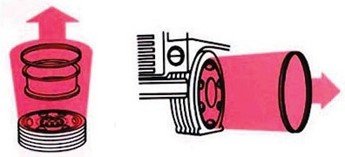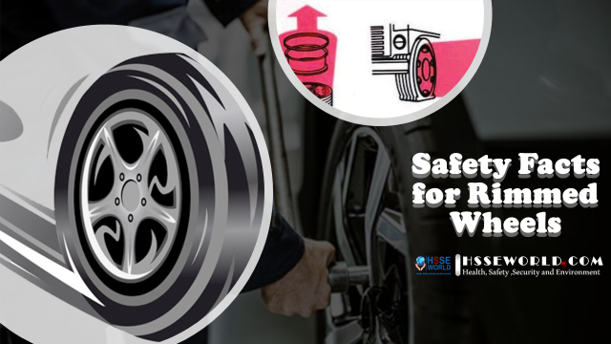Rimmed wheels on large trucks, buses, and off-road equipment have tires that are inflated to dangerous pressures. There- fore, workers who service these wheels should practice the wheels safety rules established by the Occupational Safety and Health Administration (OSHA) standard 1910.177 entitled “Servicing multi-piece and single-piece rim wheels.”Accidents involving rimmed wheels usually occur during tire inflation. Either the lock rings or the bead wires blow off of the tire, causing serious injury or death. Under the OSHA standard, employers must train all employees who will be servicing rimmed wheels. in this article, you will be familiar with Rimmed Wheels safety Facts.
Also Read: Risk of Explosion during Removal of Split Rim/Multi Piece Wheels from Vehicles-Safety Moment #8

General
At the minimum, the employee must be trained in using the data found in the rim manuals, as well as, the contents of the standard. If an employee is unable to read and understand the manuals, the employer must insure that the employee is trained in a manner that allows him or her to understand The best way an employer can make sure that an employee has learned how to perform tasks according to the OSHA standard is to have the employee demonstrate their skills by performing all the tasks. If they fail to perform the tasks properly, they must be re-trained.
Employers must make sure that each employee demonstrates the following tasks according to the OSHA standard: wearing safety glasses or goggles, reading and following the manufacturer’s instruction manuals, handling wheels with mechanical lifting and moving devices, deflating and demount tires, inspecting and identifying the wheel components as well as the pressure limits and condition of tires, mount and safely inflate tires inside a retaining device (safety cage), safely inflate the tire when a single-piece rim wheel is mounted on a vehicle, never leave an airline unattended when inflating a tire, and stand outside the trajectory area of any parts and air blasts that might fly off of the tire if an explosive separation occurs during inflation and post-inflation inspection.
Also Read: How To: Read a Tire Sidewall
Inflating Wheel Rims

The employer must furnish safety cages for inflating both multi- and single-rim piece wheels unless the single-rim piece wheels are solidly bolted to the vehicle before inflation. Each cage has to be able to withstand the force that would be thrown against it during a rim separation at 150 percent of the tire’s maximum rated pressure. Cages must be visually inspected before the beginning of each workday. If they show cracked welds; bent, broken, or corroded components; or any other damage that would make them less effective, they must be removed from service and not used until correctly repaired. If repairs require replacement parts or welding, either the manufacturer or a professional engineer must certify that the repairs have brought the cage back to its original ability to withstand force.
The employer must furnish only manufacturer-recom- mended tools to service the wheels. They also must furnish charts and manuals for all the types of wheels and tires being serviced. The inflation air line assembly must have the fol- lowing tools:
- a clip-on chuck,
- an in-line valve or pressure regulator, and
- sufficient hose to allow the worker to stand in safe areas when inflating tires.
Inspecting Wheels
When the employee inspects wheel components prior to the assembly he or she should look for breaks, cracks, out-of-round rings, deep tool marks on rings or gutters, pits from corrosion, and any components that are bent out of shape. If any of these defects are found, the part must be tagged and removed from the area for disposal. They may not be repaired or re-used. To reduce possible liability, components should be destroyed before disposal. Before assembly, the rim flanges, rim gutters, rings, bead seating surfaces, and tire beads must be free of dirt, rust, or loose rubber. Lightly rusted rims can be cleaned and repainted. The components and tire should be checked to make sure that the bead diameter, tire/wheel widths, and types all match. Never use unknown components.
Don’t use rings with wide gaps between the ends, or butting ring ends unless specified by the manufacturer. Inspect tires for cracks, cuts, and imbedded objects.
Servicing Multi-Piece Rim Wheels
The employer must establish safe operating procedures for servicing multi-rim wheels. Tires shall be completely deflated by the removal of the valve core. Check that the valve stem is not blocked by inserting a wire into it before demounting from the wheel.
Before removing the wheel from the axle the tire must be completely deflated in either of the following situations When the tire has been driven while under-inflated at 80 percent or less than its rated pressure.
When there is obvious or suspected damage to the tire or wheel components. Rubber lubricant must be applied to the bead and rim mating surfaces during assembly of the wheel and infla- tion of the tire unless the manual recommends against it If a tire on a vehicle is under-inflated but has more than 80 percent of the rated pressure, it may be inflated while the wheel is on the vehicle, provided that remote control equipment is used and no one stands in the trajectory area during inflation.
Tires shall be inflated outside of a safety cage only to the minimum pressure that forces the tire bead onto the rim ledge and makes an airtight seal.
When a wheel is in a cage the employee should not lean or rest any part of his body or equipment against the cage After full inflation the wheel must remain in the safety cage while components are inspected for proper seating and locking.
If adjustments must be made, the tire must be completely deflated by the removal of the valve core. No adjustments may be made to the seating of the side and lock rings by hammering, striking, or forcing while the tire is inflated No heat shall be applied to a multi-piece wheel or any of its components.
Also Read: Safety Facts for Driving in Bad Weather
Servicing Single-Piece Rim Wheels
The employer must also establish safe operating procedures for servicing single-rim wheels. Tires must be completely deflated by removal of the valve core and checked for a blocked valve stem before demounting from the wheel.
Mounting and dismounting of the tire shall only be done from the narrow ledge side of the wheel, taking care not to damage the tire beads.
Rubber lubricant must be applied to the bead and wheel mating surfaces during assembly of the wheel and inflation of the tire unless the manual recommends against it If a tire-changing machine is used, the tire shall be inflated only to the minimum pressure needed to force the bead onto the rim ledge.
If a bead expander is used it must be removed before the valve core is installed and as soon as the bead slips into the bead seat Tires can only be inflated when inside a safety cage, behind a barrier, or fully bolted to the vehicle. Any flat, solid barrier must be more than one foot from the wheel during inflation.
Tires must not be inflated to more than the inflation pressure stamped on them unless recommended by the manufacturer Tires must not be inflated above the maximum pressure recommended by the manufacturer to seat the tire bead firmly.
No heat shall be applied to a single-piece wheel or any of its components. The view the rimmed wheels safety rules established by the Occupational Safety and Health Administration (OSHA) standard 1910.177 entitled “Servicing multi-piece and single-piece rim wheels”, visit www.osha.gov
Also Read: Tool Box Talk: Hand Grinder Safety
Review Quiz
- When do most accidents usually occur?
- a- When tires are being mounted on the rims.
- b- When tires are being inflated.
- c- Mondays and Fridays.
- Employees must be able to demonstrate that they can:
- a- Read and follow manufacturers’ instruction manuals
- b- Handle wheels with mechanical lifting and moving devices
- c- Mount and safely inflate tires inside a retaining device
- d- All of the above
- Retaining cages must be inspected before beginning each workday. True or False?
- Employers must furnish cages that will withstand a rim being thrown against them at:
- a- 50% of the tire’s maximum rated pressure
- b- 100% of the tire’s maximum rated pressure
- c- 150% of the tire’s maximum rated pressure
- d- 200% of the tire’s maximum rated pressure
- Lightly rusted rims:
- a- Must be cut up and discarded.
- b- Can be cleaned and repainted.
- c- Cannot be re-used
Answers
1 – b, 2 – d, 3 – True, 4 – c, 5 – b.
For more safety Resources Please Visit Safetybagresources




